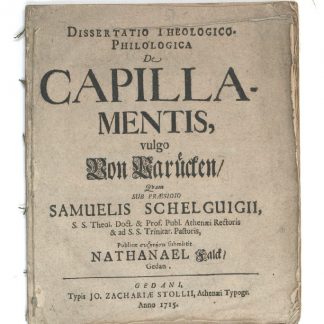"A frank treatise on virginity and the ways of losing it" (Garrison/M.)
Notae virginitatis oder wahre Kenn-Zeichen von denen Geheimnissen der Jüngferschafft, wie und auf was Art und Weise solche eigentlich zu erkennen, ob sie nemlich corrumpiret, oder nicht. Desgleichen umständliche Nachricht von der Schwängerung selbsten und neun-monatlichen Geburth; wie auch von dem Ursprung und Anfang derer Theile oder Glieder, wie solche im Mutter-Leibe formiret und gebildet werden. Samt Petri Gassendi Tractat von der Scheidewand des Hertzens, welche die beyden Hertz-Kammern unterscheidet, und wie solche ihre Durchgänge habe.
8vo. (6), 360, (16) pp. Title-page printed in red and black. With engraved frontispiece.
(Bound with) II: Deventer, Hendrik van. Neues Hebammen-Licht, bey welchen die Hebammen-Kunst und was darzu gehöret durch geschickte Handgriffe aufrichtig gelehret wird. Jena, Heinrich Christoph Cröcker, 1717. (12), 489, (23) pp. Title-page printed in red and black. With engraved frontispiece and 33 (instead of 37) engraved plates. Contemporary vellum with handwritten spine title. Edges sprinkled red.
€ 950.00
I: Rare first independently published German edition (first printed in Paris in 1597 as "Opusculum physiologum & anatomicum"), translated by Christoph von Hellwig (1663-1721). "In 1595 Pineau demonstrated the vestigial foramen ovale in the adult heart, settling the question of the perviousness of the septum of the heart [...] [In 1597] he published this study in a frank treatise on virginity and the ways of losing it" (Garrison/M.). "The German edition was prohibited by the magistrates. The chief interest of the book now relates to the supposed parturition of the pubic bones during parturition [...] Pineau was a lithotomist and had the Collot family secret" (Osler). The work has previously been issued in German as part of Louise Bourgeois Boursier's "Hebammen Buch" (1626).
II: Second German edition of Deventer's magnum opus, "Operationes chirurgicae novum lumen exhibentes obstetricantibus" (first published in Leiden in 1701, also in Dutch), one of the most important works in the history of obstetrics. "Gives the first accurate description of the female pelvis and its deformities, and the effect of the latter in complicating labour" (Garrison/M.). Van Deventer (1651-1724) is the first to appreciate fully the importance of the osseous pelvis, the axis in particular, for parturition; the procedure he recommends to midwives is exemplary. The diagnosis of abnormal foetal positions and the obstetrical techniques show great refinement. While Deventer championed manual procedures and discouraged the use of instruments if they could at all be avoided, he is hailed as the inventor of the most important obstetrical instrument of all: the forceps. "Deventer is unquestionably the greatest and scientifically the best-educated obstetrician of his age. His research not only blazed new trails, but formed the basis on which modern obstetrics is built to this day" (cf. Hirsch).
Lacks plates no. 5, 10, 12, and 14; large defects to frontispiece and two additional engravings; several engravings trimmed closely near the edge.
From the collection of the Swedish Polar explorer and mineralogist Gösta Bodman (1875-1960), who participated in the Swedish Antarctic Expedition of 1901-04, with his pretty, topical bookplate (showing a penguin and a research ship) on the pastedown.
I: Hayn/Gotendorf IX, 460. Cf. Blake 205. Wellcome IV, 388. Garrison/Morton 802. Waller 7450ff. Osler 3679.
II: Blake 118. Waller 2420. Hirsch II, 173. Cf. Wellcome II, 460. Garrison/Morton 6253. Norman 631. Eimas 678.






